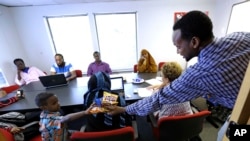More than 2 million immigrants from sub-Saharan Africa live in the United States. A new study from the Pew Research Center finds that they are, on average, college-educated and employed. In fact, they are more likely than native-born Americans to have pursued advanced degrees. And they are employed at about the same rates as the general population.
The study is important for several reasons. First, it shows that most sub-Saharan Africans living in the U.S. do not fit a stereotype of a struggling, out-of-work person with little schooling.
The study also shows that the sub-Saharan African immigrant population is different in the U.S. than in Europe. For example, in the U.S. more than two out of three sub-Saharan African immigrants have at least some college education. In Britain, half do. In France, one in three do. And in Italy, only one in ten has had higher education.
In addition, sub-Saharan African immigrants in the U.S. are more likely than those in Europe to be working. The Pew study found that employment rates were about equal to the general population in each country. About 93 percent of sub-Saharan African immigrants in the U.S. are working, compared to 92 percent in Britain and 80 percent in Italy.
Monica Anderson is a researcher at Pew and one of the writers of the report. She told VOA that the research team wanted to compare the backgrounds of African immigrants in the U.S. to those in Europe.
“What we found is that the sub-Saharan African immigrant population [in the U.S.] really stands out, and that they are a very highly educated group,” Anderson said over the phone.
The Pew study is based on 2015 data from the U.S. Census Bureau and Eurostat’s Labor Force Survey.
Ease of reach
One reason for different backgrounds among sub-Saharan African immigrants is proximity, Anderson said – in other words, how close things are to each other. Europe is much easier to reach than the U.S. for low-income Africans. They can come by boat or other ways, whether or not the travel is safe. Hundreds of thousands have risked crossing the Mediterranean Sea to go to Italy or Greece.
In contrast, African immigrants coming to the U.S. often have the money to travel by plane, as well as permission to enter the country once they arrive.
They come to the U.S. for different reasons – to study, for employment opportunities, through family reunification programs. Some come to the U.S. as asylum seekers and refugees.
The State Department said that in 2015, Africans made up almost half of those invited to ask for immigrant visas through a lottery program.
And the Department of Homeland Security reported that in 2016, about one-third of refugees approved to enter the U.S. were from Africa.
Better off?
But previous research found that higher education and employment levels do not always mean a higher quality of life for African immigrants in the United States.
In 2015, researchers at Pew looked at black immigrants from Africa, the Caribbean, Central America and South America. Researchers found that that their median household income was more than $8,000 lower than the U.S. average.
They also owned homes at a rate less than the overall U.S. population, and were more likely to live below the poverty line.
The findings suggest that even though sub-Saharan African immigrants have high education and employment rates, they may not have all the opportunities other groups enjoy.
I'm Dorothy Gundy.
Salem Solomon reported this story for VOA. Xiaotong Zhou adapted it for Learning English. Kelly Jean Kelly was the editor.
______________________________________________________________
QUIZ
______________________________________________________________
Words in This Story
stereotype – n. an often unfair and untrue belief that many people have about all people or things with a particular characteristic
stands out – v. a person or thing that is better or more important than the others in a group
proximity – n. the state of being near
lottery – n. a system used to decide who will get or be given something by choosing names or numbers by chance
median – adj. in the middle












